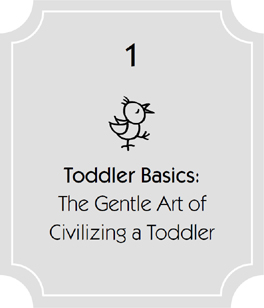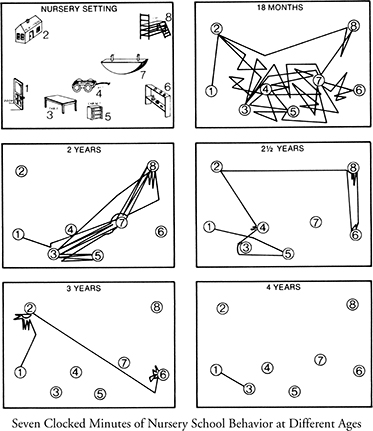“A two-year-old is kind of like having a blender, but you don’t have a top for it.”
—Jerry Seinfeld
Main Points:
• Toddlers aren’t mini-adults, or even mini–big kids. They’re more like uncivilized little cave-kids.
• Our homes tend to be either too boring or too stimulating for our toddlers.
• Your tot’s brain struggles with language and logic … especially when he’s upset.
• Your toddler’s normal developmental drives often put him on a direct collision course with you.
• You’ll find parenting makes a lot more sense once you figure out your child’s unique … temperament.
 Help! There’s a Neanderthal in My Kitchen
Help! There’s a Neanderthal in My Kitchen
Would you like to help your child become the best, most cooperative toddler on your block? You’ll be most successful if you keep in mind this one key fact: Toddlers act less like little schoolkids than they do like uncivilized little … cavemen.
Wait a minute, you might be thinking. Did he just compare my child to a caveman? Yup, I did!
Of course, toddlers aren’t really cavemen, but they do exhibit lots of pretty primitive behaviors, like grunting and pointing, wiping their noses on their sleeves (or yours), scratching and biting when angry, and peeing anywhere they want. No wonder the mom of a headstrong 18-month-old jokingly told me, “It’s like there’s a tiny Neanderthal living in my house!”
In fact, between your child’s first and fourth birthdays, his rapid maturation will greatly resemble a superfast rerun of ancient human development. It’s thrilling to watch as the same great achievements that took our primitive ancestors eons to master spring forth in our children over the space of just three years:
• walking upright
• the ability to skillfully use the hands and fingers
• talking
• juggling ideas (comparing/contrasting)
• beginning to read
One of your biggest challenges during these years will be to teach your child the finer points of “civilization,” such as manners, patience, and concern for others. But I promise that you will be much less frustrated and much more successful teaching these good behaviors once you recognize that your uncivilized little friend is far from a fully rational and logical person.
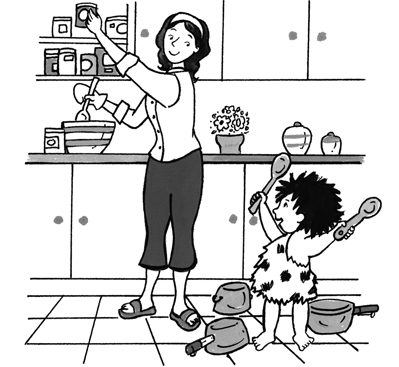
The Little Adult Assumption 
To soothe a toddler who is having a blowup, many parents are taught to calmly acknowledge their child’s unhappy feelings and then gently correct them: “Jane, I know you want the ball, but it’s Billy’s turn. Remember we talked about sharing? So please give the ball back to Billy. You can have the next turn. Okay?”
Sounds reasonable, but mature comments like those often backfire and can make livid toddlers shriek even louder! That’s because little children aren’t mini-adults. Their immature toddler brains struggle to understand long sentences and to control their bursts of powerful emotions.
Psychologist Thomas Phelan, author of 1-2-3 Magic, calls our attempt to use calm logic to soothe upset toddlers “the little adult assumption.” By that he means we are expecting stressed-out toddlers to settle down because of our explanations and our polite appeals to reason—which is simply unrealistic. Too many parents believe their little ones should be able to turn off their emotions mid-tantrum and maturely reply, “Thank you for explaining that, Mother. I’ll happily do what you want.” Hmmm … I don’t think so!
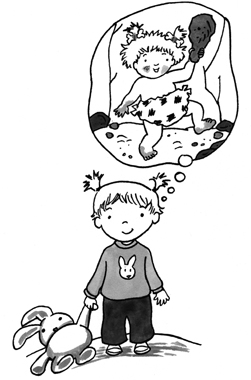
You’ll be far more successful calming your upset tyke and getting his cooperation if you replace adult-style statements with the simple, basic phrases you’ll learn in Chapters 3 and 4. And believe me, you’ll have plenty of opportunity to practice this special approach over the next few years, because even sweet, happy toddlers have emotional upsets several times a day.
Why are toddlers so prone to outbursts? There are many reasons, but here are the top four….
Your Toddler’s Four Big Struggles 
We all know how tough it is to raise and civilize a toddler, but have you ever stopped to think how tough it is to BE a toddler?
From your toddler’s perspective, she is losing all day long! She’s weaker, slower, and shorter than everyone else … and that’s just the start of her challenges. Toddlers face four big struggles every day that make it extra-hard for them to behave like little angels.
• Our modern world is weird to them.
• Their brains are out of balance.
• Their normal development can make them misbehave.
• Their temperaments can make them overreact.
Toddler Struggle #1: Our Modern World Is Weird to Them.
We assume that living in a house or apartment is normal, but it’s actually a very weird environment for toddlers. That’s because for 99.9 percent of human history, children spent most of every day frolicking … outside.
Imagine inviting Tarzan to live with you. There’s a good chance he’d go totally bonkers. Compared to his jungle home, yours delivers an unpleasant double whammy: terribly dull in some ways, yet way too exciting in other ways.
Similarly, our homes are both boring and overstimulating to our little kids … at the same time. They’re boring because they replace the exciting sensations of nature (the bright colors, the feeling of the wind on their skin, the brilliant sun, the soft grass, etc.) with an immense stillness (flat walls, flat floors, no wind, no fluttering shadows, no birds chirping). Additionally, many traditional toddlers’ delights (running after kids and dogs, throwing dirt clods, catching bugs, climbing trees) are literally beyond reach.
When you think of it that way, it’s no wonder so many kids are bouncing off the walls by late morning.
Yet, at the same time our modern world can be too stimulating to toddlers. It bombards them with jolting experiences that kids in the past never had to deal with: crazy cartoons, slick videos, clanging computer games, noisy toys, and bright colors everywhere. We may be used to all this, but it can make many little children feel stressed.
As the day wears on, all this over- and understimulation can drive many little kids over the edge into fatigue, irritation, and misbehavior. Uh-oh! Tilt … tilt … tilt!
Toddler Struggle #2: Their Brains Are Out of Balance.
Your toddler’s brain is like a buzzing beehive with twenty billion cells and 50 percent more nerve connections than we have in our big heads! All these connections mean millions—or billions—of signals zipping around. “Go here!” “Go there!” “Touch it!” “No, don’t!” Yikes! No wonder little kids spin out of control.
To help manage this whirlwind of mental activity, our brains are split into a right half and a left. The two halves of the brain look alike but do very different things. The left half is the methodical nerd of the nervous system. It loves details: picking the right word, counting the toys, and solving problems … step by step. It helps us listen carefully, be logical, and stay calm.
The right half is the hyper “Speedy Gonzales” of the nervous system. It’s great at quick decisions, instant face recognition, and bouncing to the beat of any type of music. Unlike the thoughtful left side, the right side is distractible, impulsive, and emotional.
The two halves of the brain are in pretty close balance in big kids and adults, but the left side tends to be a bit more in control. Guess which half runs the show in toddlers? Yup, you guessed it … the right. In fact, your tot’s emotional right side is so busy and noisy it often ignores the patient voice of the left side telling it to settle down.
And as if all that weren’t challenging enough, your toddler’s brain gets thrown even more off balance when she’s upset. Big emotions instantly shut down the thoughtful left brain and dramatically amp up the primitive right.
In truth, this same imbalance occurs in adults, too (that’s why we “go ape” when we’re upset). But since toddlers are a whole lot more impulsive to begin with, our little friends shriek, spit, crash into tables, run into streets, and act even more like Neanderthals than usual when they get upset.
Despite these difficulties, your toddler’s right brain has one absolutely spectacular ability that will become one of your best tools for connecting with her and civilizing and calming her, too: the capacity to respond to “nonverbal” communication. Even when her immature left brain gets hopelessly confused by your words, her right brain will have no problem understanding your tone of voice, the look on your face, and your gestures … even when she’s upset.
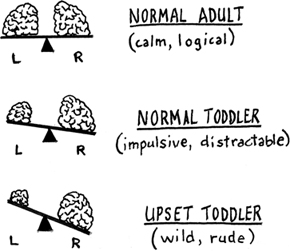
You don’t need to become a brain expert, but knowing a bit of science will help you understand one very important point: Talking directly to the right brain when your child is upset, by using your tone of voice, gestures, and body language to mirror a bit of her emotion, is the key to helping her calm back down. You’ll become an expert at this method when you learn the Fast-Food Rule and Toddler-ese in Chapter 3.
By the end of your child’s toddler years, you’ll easily be able to see her “new and improved” left brain taking more control. This will help her be more verbal, more focused, and less likely to pop like a firecracker at every little frustration.
Sign Language: Young Kids Know
More Than They Can Say
When you think about it, it’s not so easy to talk. Like a marching band, your lips, tongue, and throat have to move together with perfect split-second teamwork.
It takes most kids two to three years to get really good at speaking, but a fun way to jump-start your one-year-old’s ability to “talk” is to teach her to sign. Remember, your toddler’s right brain is an expert at reading gestures. That’s why even very young toddlers can learn sign language.
Jane noticed that her 15-month-old son raised his hands whenever he wanted to leave. So she started to use this sign to “tell” him when it was time to go.
There are many good books that help parents teach their children sign language. Or you can just make up your own signs. Here are a few easy ones you’ll have fun with. Say the word out loud as you show your child the gesture.
• Put your hand to your mouth for “eat.”
• Suck on your fist for “drink.”
• Stroke the back of your hand for “doggie.”
• Wiggle your finger for “worm.”
• Sniff to mean “flower.”
• Pat the top of your head for “hat.”
• Repeatedly open, then clench your hand for “breast-feed.”
Four-year-olds are definitely more patient, more civilized, and well on their way to growing up.
(Want to read more about how your child’s brain works? I recommend taking a look at these two great books: What’s Going On in There?, by Lise Eliot, and The Scientist in the Crib, by Alison Gopnick, Andrew Meltzoff, and Patricia Kuhl.)
Toddler Struggle #3: Their Normal Development Can Make Them Misbehave.
Believe it or not, toddlers are biologically driven to do many of the things that drive us bonkers. Let’s focus on a few of the developmental characteristics typical of all toddlers, and likely to put them on a collision course with their parents:
• Toddlers are compulsive walkers … and climbers. After months of being limited to lying down, sitting, and crawling, suddenly being able to walk and climb is absolutely thrilling. Your primitive little friend will roam around nonstop from dawn to dusk, feeling Wow, this is soooo cool!
• Toddlers are very self-centered. Most toddlers demand to be in the spotlight: Talk about me! It’s a wonder their first word is usually “ma ma” … and not “me me”!
• Toddlers have trouble switching gears. Little tots often have trouble going from one activity to the next. They seem like machines without an “off” switch. You see this all the time in their play: Whee! Let’s whack this drum … a thousand times in a row!
• Toddlers have the attention span of a bumblebee. Young kids flit from thing to thing. Their high degree of distractibility is perfectly illustrated in the following diagram, from Louise Bates Ames and Francis Ilg’s wonderful book, Your One-Year-Old. As toddlers mature, they gradually become able to focus their concentration for longer periods of time.
• Toddlers are rigid. Two-year-olds are not famous for flexibility. You can see this even in the way young toddlers approach the rules of language. For example, once they learn that adding “s” makes things plural, they may say “foots” instead of “feet,” and are likely to continue doing so no matter how many times you correct them. The same is true for their lack of flexibility about any changes that occur in their daily lives. For example, your tot may get really upset if one night you deviate from your normal routine and forget to say “Sweet dreams!” to her dollies. And like us, the more stressed and tired they feel, the more rigid they become.
• Toddlers can’t stop pushing the limits. A parent’s job is to set smart limits, and a toddler’s job is to push those limits. Toddlers literally can’t stop themselves from exploring, touching, and pulling on everything. That’s how they learn about the world and about themselves. So while you may feel that your little friend keeps defying you, she may feel you’re unfairly blocking her greatest joy—discovery.
Toddler Struggle #4: Their Temperaments Can Make Them Overreact.
Every toddler is a totally unique person with his very own face and voice … even his personality is one-of-a-kind.
Each child is born with a personality as matchless as his fingerprints. It’s a mixture of intelligence, humor, and a fascinating quality called temperament.
His temperament is his style of interacting with the world: his pacing, attitude, flexibility, and general mood. Is he cautious or brave? Stubborn or easygoing? Mild or passionate? Temperament explains why some of us can sleep with the TV on while others go nuts with the tiniest noise, why some forgive easily and others just can’t let go. Knowing your child’s temperament helps you know when to pamper and when to push.
Temperament tends to pass from parent to child. So, shy parents often have shy kids and passionate parents usually have little chili peppers. But sometimes nature throws a curveball and a couple of librarians beget a heavy-metal rocker!
Knowing your child’s developmental stage tells you what milestone he’s approaching, but knowing his temperament lets you predict whether he’ll greet it with gusto or approach it with caution.
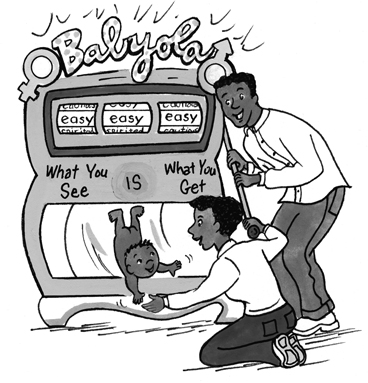
So what temperament does your child have? Is he a calm little Buddha or Attila the Hun? In general, temperament comes in one of three categories: easy, shy, and spirited. While some kids fall between these categories, about three out of every four are easy to peg.
Easy temperament
Evan, 26 months old, wakes up in a good mood and wanders into the kitchen for breakfast. But a potential crisis occurs when his favorite cereal is “gone-gone” after only a few flakes have been poured into the bowl. His dad, Chuck, quickly takes another brand of cereal from the pantry and sprinkles it into the bowl. “Mmm!” Chuck urges. “Your other favorite! Ohmygod it’s yummy! Try it!” Evan plunges his spoon into the milk—and finishes the whole bowl!
About half of all kids are easygoing. They wake up “on the right side of the bed,” cheerful and ready for a new day. They’re active (but not wild), tolerate changes well, and enjoy new people and situations.
Easy kids are resilient. They bounce back from bangs and disappointments with a smile. Yet when push comes to shove, they’re perfectly capable of both pushing and shoving!
Shy temperament
Eighteen-month-old Jesse was a cautious guy. His mom, Jody, said, “He only speaks four words, but he’s a thinker. He practices things in his mind before he does them.” At the park, he spent weeks carefully watching kids crawl through a little tunnel. Then one day he tried it himself. After he made his way through, he was so giddy that he did it twenty times in a row.
About 15 percent of kids are shy, cautious, and slow to warm up to new experiences. By nine months most easy babies smile at strangers passing by, but shy kids frown and cling to us for safety, frequently waving bye-bye only after a guest leaves. Cautious kids are often extra-sensitive. They don’t like their milk too cold or pants that are too scratchy. They’re easily frustrated, fearful, and clingy, often trailing us from room to room, and unhappy with changes. Cautious kids also tend to be very observant. These are the kids who recognize where they’re going and may start to cry a block before you even arrive at the doctor’s office! They are often early talkers but late walkers, and their motto is “When in doubt … don’t!”
Your shy tot may start the “terrible twos” early (15 to 18 months), but if you treat him with patience and respect he will finish the toddler years happy and confident. (Warning: Shy, cautious young children should be shielded from pressure and excessive criticism. That type of rejection can make a shy child fearful and rigid for the rest of his life.)
Spirited temperament
Fifteen-month-old Gina stays busy from dawn till dark, flying from one activity to another. “If she can’t open a door, she knocks it down!” says her mom. When she’s moving, she’s happy. But her constant activity means she forever needs boo-boos kissed, trips to the park, and parents who are vigilant about childproofing the house.
One in ten toddlers is a strong-willed, spirited tyke. These “roller-coaster kids” have high highs and low lows. And when the sparks of daily stress mix with the TNT of their explosive personalities … KABOOM!
Parents usually know if they have a spirited/challenging child, because they’re the “more” kids:
• more active (they run farther, jump higher, and spin longer)
• more impatient (they hate sharing and taking turns)
• more impulsive (they’re easily distracted and accident-prone)
• more defiant (they run to the curb, look back at you … then dash into the street)
• more rigid (they get so upset, they keep crying even after getting what they want)
• more intense (they get very glad, very sad, and very mad)
• more sensitive (their feelings are easily hurt)
These superactive kids range from cheery to moody, stubborn, and defiant. Fortunately, spirited children usually grow into happy, enthusiastic kids as long as they get lots of outside play, consistent but flexible limits, and a steady supply of patience and love.
 Temperament: Easy, Shy, or Spirited
Temperament: Easy, Shy, or Spirited
Let’s take your toddler’s temperament “temperature.” Look over these nine traits and circle the words that best fit your child.
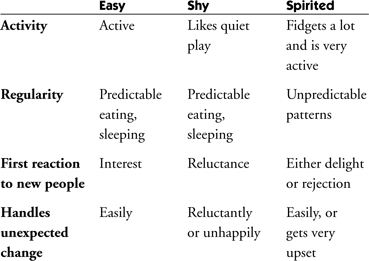
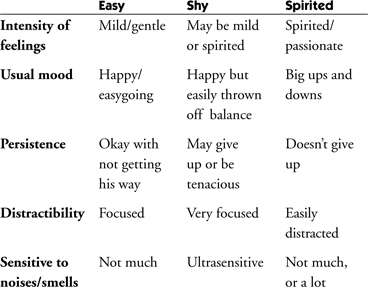
Variety Is the Spice of Life
(and the Foundation of Society!)
It would be terrible if there were no doctors in the world, but it would also be terrible if everyone were a doctor. We need leaders and followers, thinkers and doers, worriers and risk-takers. Different temperaments help fill all the niches of society.
So although you may unexpectedly find yourself with the tough job of raising a saber-toothed tiger, remember that some day your little tiger will have an important role to play in the world.
 The Ten-Second Temperament Test
The Ten-Second Temperament Test
Still not sure which category describes your child? This little test may help: Go to an uncrowded mall, release your child’s hand, and pretend to turn your back for two seconds. (Keep a close watch out of the corner of your eye.) What does she do? Stand there? (Easy.) Grab your coat and cry? (Shy.) Run away without looking back? (Spirited.) The answer will give you a pretty good reading of your child’s temperament.
Now that you have a better sense what makes your little friend tick, and what may be preventing her from behaving the way you want her to, let’s explore the special struggles that the parents of toddlers face every day.
